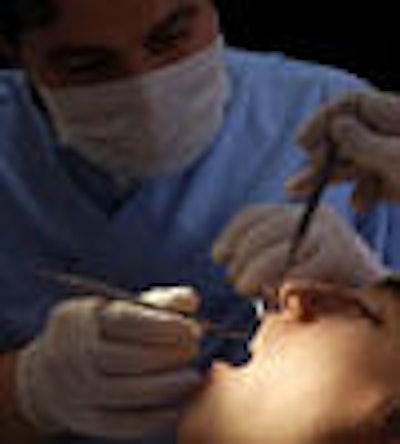
When it comes to deep carious lesions, conventional wisdom (i.e., G.V. Black) has long said that "it is better to expose the pulp of a tooth than to leave it covered only with softened dentine."
But for years some have questioned whether completely removing the infected dentin from lesions approaching the pulp is always necessary. Clinical studies supporting partial caries removal and stepwise excavation have shown, in fact, that these methods can be preferable to full excavation in cases of deep carious lesions where there is risk of pulp exposure (Cochrane Database of Systematic Reviews, 2006; 3:CD003808).
Now an article by researchers from the Practitioners Engaged in Applied Research and Learning (PEARL) Network at New York University College of Dentistry is calling the conventional wisdom into question once again. Among other things, the authors conclude that, after reviewing numerous clinical studies involving the use of partial removal or stepwise excavation to treat deep carious lesions, "there is substantial evidence that removing all vestiges of infected dentin from lesions approaching the pulp is not required for caries management" -- provided that the restoration can seal the lesion from the oral environment effectively (Journal of the American Dental Association, June 2008, Vol. 139:6, pp. 705-712).
The PEARL researchers conducted a systematic search of five databases (Medline, Evidence-Based Medicine Reviews, the Cochrane Database of Systematic Reviews, Cochrane Central Register of Controlled Trials, and OVID's Database of Abstracts of Reviews of Effects) using a set of relevant keywords, including "deep caries," "partial caries," "indirect pulp capping," and "stepwise excavation."
They limited the search to reports written in English that were published between 1950 and 2007. Their literature search yielded 1,059 articles; 23 were deemed "directly relevant," according to the authors.
"This was not an academic exercise," noted lead author Van Thompson, D.D.S., Ph.D. Rather, it was an attempt to bring an evidence-based approach to a fundamental practice in general dentistry, he said.
"What do you have to present to dentists to make them change? If you can get a number of dentists in day-to-day practice to look at the results and you can show that leaving some caries in deep restorations has a good track record, you can begin to convince them that this [partial caries removal] does work," Dr. Thompson said.
In their analysis, Dr. Thompson and his co-authors noted that "Although there is substantial evidence to the contrary, most practitioners continue to follow the basic principle guiding any surgeon: that one must eradicate any and all affected tissue from the site of an infection."
But current science no longer supports this as the only alternative, according to Douglas Young, D.D.S., M.S., M.B.A., an associate professor at the University of the Pacific School of Dentistry, who specializes in caries management.
"Clearly the science has advanced, yet traditional dentistry is slow to adopt new techniques," Dr. Young said. "The economic-driven model we have is dentists get paid to do fillings and restoration, not to treat disease. And caries is a disease."
What was the best science 100 years ago might not be the best science today, he added.
"There is no proof that removing all the decay is better than leaving some of the decay," he said. "The concept of leaving decay sometimes is blown out of proportion. The Thompson paper suggests that you would only leave decay on a vital asymptomatic tooth where, if you were to remove that decay, you would require root canal treatment. We are not saying to leave decay in any other situation. We want to remove as much decay as possible without endangering the pulp, and the perimeter of the lesion has to be sealable."
However, despite Dr. Thompson and colleagues' contention that the evidence supporting the use of partial caries removal is substantial enough to warrant serious consideration, getting dentists to adopt such a fundamental change in their everyday practice continues to be a challenge.
"It comes down to peer pressure," Dr. Thompson said. "Many dentists think that a partial removal will fail sooner, which means they are not doing service to their patients. Many also feel that if they do [a partial removal], the patient could go to someone else and have a radiograph taken and that radiograph will show that there was caries left and they [the dentist] will be judged."
This fear goes beyond just being judged by their peers, Dr. Young added.
"Where this issue gets emotional is the concept of leaving decay in the tooth," he said. "Would this be considered malpractice? And we can't ignore the ethical question: Would you knowingly cause a tooth to have a root canal, either for economic reasons or for worrying about malpractice?"
Kevin Donly, D.D.S., M.S., chair of pediatric dentistry at the University of Texas, San Antonio, thinks the research still isn't strong enough to support a sea change in terms of the standard of care for deep caries treatment -- despite the fact that pediatric dentists have in essence been performing partial caries removal for some time in the form of indirect pulp caps.
"If partial removal is done the way it is supposed to be done, when the patient is asymptomatic so there is no pulpal involvement, I think this procedure is supported," he said. "But really there needs to be more well-controlled clinical trials, and this paper [the JADA article] lets you know that. They pulled 10 trials, but really it was only six studies and less than 500 teeth total, and that is not a whole boatload of data. And most of the studies were over a two-year span or shorter, which is not sufficient long-term data. So until we have enough controlled trial data, we're all a little gun-shy."
The PEARL Network is currently conducting a long-term multisite study that aims to compare the tooth vitality at one year post-treatment of complete versus partial caries removal in deep class I lesions, assess the effects of deep caries treatment on patients' postoperative hypersensitivity and oral health-related quality of life, and evaluate the effectiveness of cavity lining and bonding techniques. PEARL practitioner-investigators from the Northeastern region of the U.S. are recruiting hundreds of patients to participate in the study, which will be conducted at their private dental practices. The study began in March 2007; patients will be followed for 36 months.



















